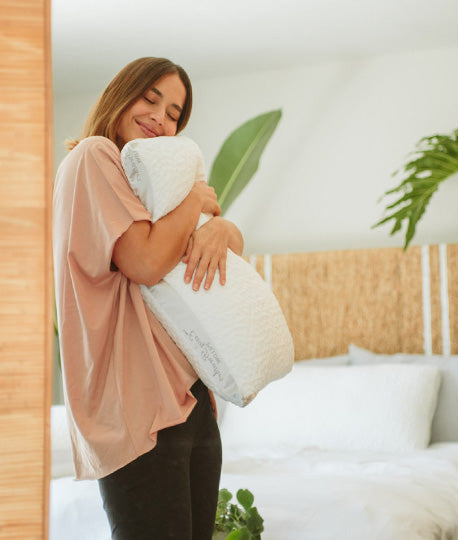Assume the (Correct) Position: How Your Sleeping Position Affects You


After a hard day's work, sometimes all you want to do is fall into bed and drift off to sleep. The last thing you want to worry about is your sleeping position. Once you do start taking your posture into account, you can save yourself from morning aches and pains.
Sleeping Position Problems
It may at first be difficult to decide which sleeping position works best for your body. It's even harder to know how to adapt since your body tends to shift during the night unconsciously.
Resting in an uncomfortable or awkward position for an entire night can cause back and neck aches. By becoming aware of your current state of sleep throughout the night, you can alter your posture to improve your rest.
Today, we'll break down the most common sleeping positions, their pros and cons, and other ways to adjust your quality of sleep. The next time you notice yourself waking up with a cramp or other ache, try one of these helpful tips to restore your body and begin sleeping with ease.
Your Back
Lying on your back is often claimed as the best way to sleep at night. Your spine is straight, and your neck avoids any dangerous positions. Unfortunately, increased bouts of snoring and sleep apnea often come with this position. Your breathing passages can become blocked, resulting in improper rest.
For those that like sleeping on their back, little changes like tilting your head or placing a pillow behind your back can help relieve sleep apnea. And you'll still be sleeping in your favorite position!
Your Side
If you discover that sleeping on your back doesn't do the trick, try becoming a side sleeper. Many purport this to be the optimal way of resting as opposed to the back due to its many benefits including reduced sleep apnea and heartburn. It's also proclaimed as the ideal position for pregnant women since it boosts circulation and reduces lower back strain.
But just like its contemporary, this position has its own adverse 'side' effects. Side sleeping causes added pressure on the stomach and lungs in addition to numbness in the arm if slept on for too long. Position your arm in a way that doesn't cause it to be crushed by your head, such as at your side or in front of your chest to prevent the restriction of blood flow.
Your Stomach
When you're exhausted, you may tend to flop onto your stomach to catch some zzz’s. Before you end up falling asleep like that, consider what it's doing to your spine.
According to the Greatist.com, this position "flattens the natural curve of the spine" increasing the risk for lower back pain. Choosing to lie on your back or your side allows for the neutral spine necessary for proper posture. If you find yourself unable to sleep in either of the preferred ways, placing a pillow under the lower abdomen will help relieve any back pain.
Your Neck
You may not sleep on your neck per se, but your neck can contribute to poor sleep form. Pillow choice is especially important when you're finding the perfect position. Select a pillow that conforms to your body to prevent uncomfortable neck pain.
Harvard Health Publishing recommends either a feather pillow or a "memory foam" pillow to aid in cervical alignment. For side-sleepers, they also suggest placing a pillow that is "higher under your neck than your head."
Another option is to go completely pillow-less. Sleepadvisor.org claims that pillows can strain your neck and reduce airflow. Toss the pillows, and you may find yourself sleeping better than ever.
6 Additional Tips for Better Posture:
Try Multiple Positions (Sparingly): The back and side positions offer certain advantages over another. Cycling through them during the night can lessen the cons of either, providing the maximum benefit of both. Just try not to overdo it, or you might toss and turn at the expense of sleep.
Lie Still: We can't predict what form our bodies will take at night. Purposefully lying still quiets the mind and body for a peaceful sleep. It relaxes the muscles and focuses our attention away from finding the perfect position, which can cause more tossing and turning.
Buy a New Mattress: A bed that doesn't conform to your body can cause problems as well. You want a mattress that balances softness with firmness. Too cushy and your head will sink into the material. Too firm and you won't find your comfort zone.
At Nest Bedding, we'll help you find the perfect mattress that addresses all your concerns and gives you a dreamy kind of luxury.
De-stress: Stress often makes us restless in bed. Taking a hot bath, listening to soothing music, and clearing our minds in meditation are some known ways to power down.
Another great way is to write down what you're going to do tomorrow on a piece of paper. You'll have it right in front of you so you won't forget (Bonus: This helps lessen anxiety!)
Identify Potential Factors: There may be unknown factors causing us pain at night. Do you sleep with a partner? If so, your body may fall into a different form due to the presence of a sleep buddy.
What sounds do you hear at night? Are you cool in bed or hot? Do your pets keep you up? Try to find as many contributing factors as possible that could be ruining your sleep.
Find the cause; be the solution!
Do Yoga: Before going to bed, yoga helps to align your spine, strengthen your muscles and improve flexibility. For those suffering from chronic pain, you'll benefit immensely from adding a few poses into your exercise routine.
How we lie at night is a crucial component in the lifetime maintenance of our health. Identifying issues with your sleeping posture now can prevent problems further down the line. Experiment with different strategies until you find yourself dreaming—not dreading—bedtime.




